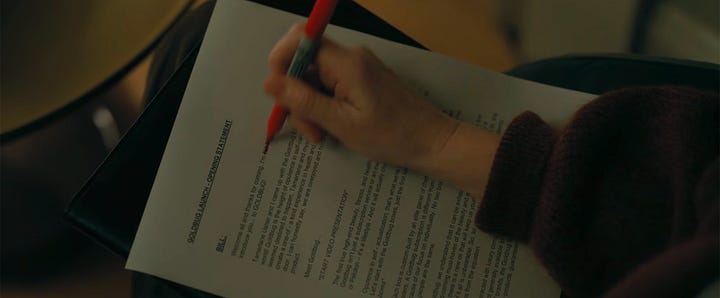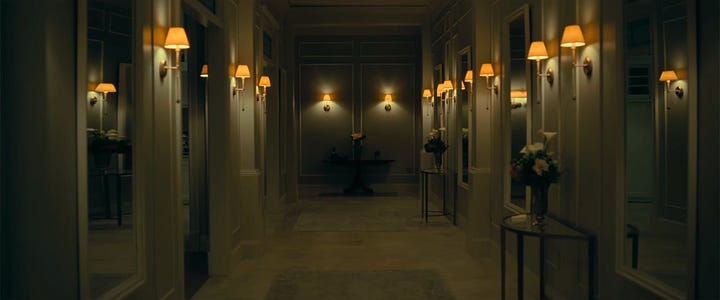Editing a Descent into Madness: THE FALL OF THE HOUSE OF USHER
Or: How To Smoothly, Calmly Depict A Mental Break
(Mild spoilers follow; not more than contained in show promos / source material)
1.06 “Goldbug” is Tamerlane Usher’s episode, and one important ‘pivot’ sequence shows her growing disorientation as she performs simple everyday tasks.
By this point, several Ushers have died in ways specifically fitting their brand of avarice, greed, and literary-esque sins. Tamerlane’s particular spiral centres around her being obsessively driven by her work, evidenced by snapping at her employees, torpedoing her relationships, and getting so little sleep she begins hallucinating . . .
or does she?
Let’s look at the techniques used to imbue the audience with Tamerlane’s confusion without making the sequence itself confusing, the edit ‘teaching’ us how to read the scene as it progresses.
First, what the sequence doesn’t do.
A few ways to insinuate someone ‘losing it’ are:
make the camera shakier as the sequence goes on
insert hyperquick unrelated shots to make you wonder if you / the character really saw something
use lenses which distort the frame (fisheye, split diopter, etc)
use whippans, extreme rack focuses, or crash zooms to quickly ‘jump’ the focus
All those have a time and place, but The Fall of the House of Usher chooses to keep both camera movement and edit smooth, so they rely on other techniques.
First, it uses a J-cut before the sequence gets ‘disrupted’. At 00:03 as Tamerlane walks out of her bedroom in a wide shot, we hear click click click before the cut to a closeup of a gas stove which is making the sound. Later in the episode as Tamerlane grows more disoriented, the sound / vision mismatch will grow more pronounced.
Next, it uses POV shots. The three key shots here are of the teapot, the papers and teacup, and the hallway.
0:10-0:27 we see Tamerlane put a kettle to boil in a wide, where we can see the cup and pot arrayed next to the stove.
It then cuts to a MCU of Tamerlane, with a jump-cut between her awake and asleep, the cut coming with a whistling kettle.


Tamerlane stumbles forward; because the above shots are framed EXACTLY alike, common knowledge of film grammar reads the scene as “she fell asleep for a moment.”
But, when the scene cuts back to the same wide as before, we see the kettle is not boiling, and the pot and cup have moved.
To emphasize this is indeed ‘wrong’ and disorienting, off Tamerlane’s bewildered look we cut to a POV shot of the teapot which is clearly been steeped and waiting.


Next Tamerlane goes to the study, where we see her POV of a full teacup and speech she is marking up.


There’s another jump-cut as she falls asleep mid-sentence and her head ‘jumps’ in the frame, then — again cutting directly from her bewildered look — we see the same POV shots, only now the cup is not only empty but dry, and the speech is covered in marks.


Having established Tamerlane’s disorientation and an editing pattern, the scene at 1:17 cuts to an angle we haven’t seen yet, all the way on the other side of the chair.
Out of focus in the background stands a shadow, which starts to move.
On the movement the scene cuts to a frame which is mostly filled with black, just for a split second, the figure effectively ‘wiping’ the screen into the establishing angle of the next shot, as Tamerlane looks up.
Tamerlane walks to the hallway and calls out, and again a shot of her confused look cuts to her POV of an empty hallway.


Or is it empty?
Because this is the third time the same pattern is repeated within 90 seconds, we already know Tamerlane can’t believe her own eyes.
Through showing repeating shots, using jumpcuts within the same shot, and clearly displaying Tamerlane’s POV with items changing, the edit makes complete sense even while depicting Tamerlane’s world making less and less sense.






